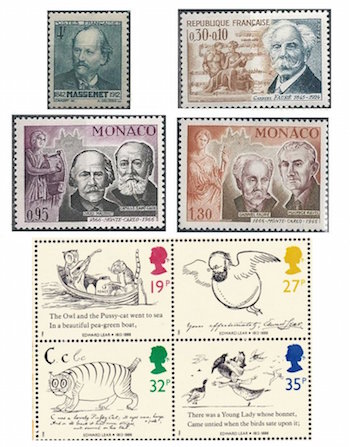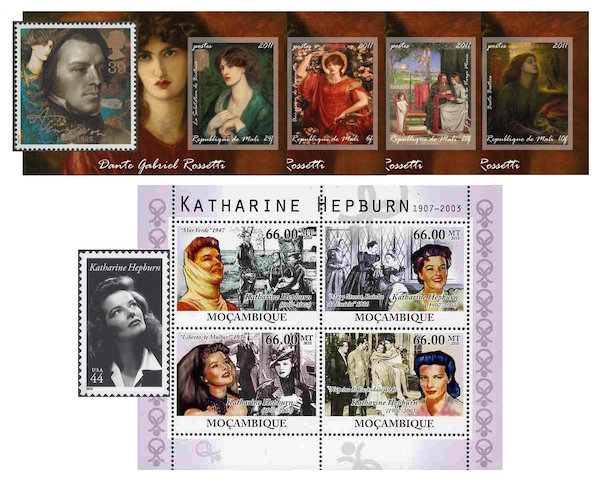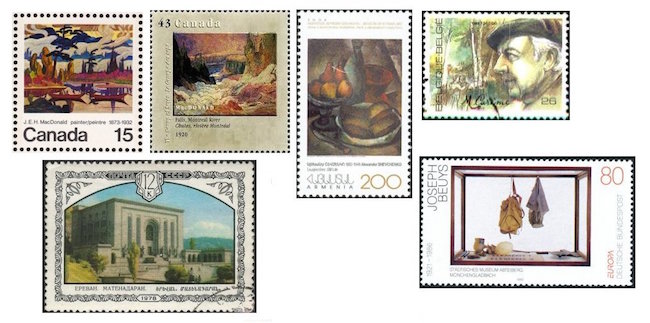The Arts on the Stamps of the World — May 12
An Arts Fuse regular feature: the arts on stamps of the world.

By Doug Briscoe
May 12 is the birthday of two prominent French composers, Jules Massenet (1842 – 13 August) and Gabriel Fauré (1845 – 4 November 1924). We also salute Edward Lear, Dante Gabriel Rossetti, Joseph Beuys, Katharine Hepburn, and seven others on stamps.
Massenet, a protegé of Ambroise Thomas, was admitted to the Paris Conservatoire at the age of nine and taught there from 1878 to 1896. As a young man he played percussion in theater orchestras, which gave him hands-on experience with the operatic repertoire (he would go on to write thirty operas of his own). He met Wagner and Liszt and served in the Franco-Prussian War, which horrified him to the extent that he would not write about it in his memoirs. His first great success in opera was with Le Roi de Lahore (1877). Massenet was one of those creative artists who every day kept to a strict pattern of writing for a set period (in his case from 4am to noon), seldom revising, a recipe for prolificity. Besides his operas, of which the most famous are Manon (1884) and Werther (1893), Massenet composed eight oratorios and cantatas, seven grateful orchestral suites, a not particularly memorable piano concerto, and 200 songs. His pupils at the Conservatory included Gustave Charpentier, Ernest Chausson, Reynaldo Hahn, and Gabriel Pierné. He was succeeded as professor of composition at the Conservatory by Fauré, who had been born three years to the day after Massenet.
Gabriel Urbain Fauré studied with Saint-Saëns, with whom he formed a friendship lasting sixty years. He took a couple of church organ posts before serving, like Massenet, in the Franco-Prussian War. Ironically, despite forty years as a professional organist, Fauré never composed a single work for that instrument (other than his admired improvisations, never committed to paper). Another parallel with Massenet was that Fauré’s first notable success as a composer came in the year 1877, with his First Violin Sonata. As stated above, Fauré succeeded Massenet as professor of composition at the Paris Conservatory in 1896; despite opposition for his “modernism”, he took over as director in 1905. Among his students were Ravel, Florent Schmitt, Koechlin, Enescu, Alfredo Casella, and Nadia Boulanger. During World War I he opposed a suggested ban on German music. On his death at age 79 he was given a state funeral. It would be remiss not to mention Fauré’s sublime Requiem, the gorgeous Pavane, his many beautiful chansons, a substantial body of lovely piano works, notably the thirteen Barcarolles and thirteen Nocturnes, his fine chamber works, and the music for Maeterlinck’s Pelléas et Mélisande.
Besides the French stamps honoring the individual composers (Massenet 1942, Fauré 1966), Monaco issued two stamps (on the same day, June 1, 1966) in which Massenet was paired with Saint-Saëns and Fauré with his student Ravel.

The delightful Edward Lear (12 or 13 May 1812 – 29 January 1888) is best known for his light verse: limericks and nonsense poems, but he is also considered to have been one of the finest ornithological artists of his time. (In 1830 at the age of 19 he published his Illustrations of the Family of Psittacidae). The next-to-last of twenty-one children, he and his elder sister Ann left home to ease the family’s financial burden, and Ann became a surrogate mother for him. Lear was afflicted with numerous health problems, epilepsy, bronchitis, asthma, depression. With his gift for drawing he was already earning money at 16, and soon he was working as an “ornithological draughtsman” for the Zoological Society. Sadly, his eyesight began to fail, but he was able to turn to painting and book illustration. He traveled much and left large numbers of wash drawings of what he saw in Italy, Greece, Egypt, India, etc. The remarkably accomplished and versatile Lear also wrote books of travel, played multiple musical instruments, and composed songs to Tennyson and others. Lear’s settings were the only ones of his verse that Tennyson approved of. Lear was unlucky in love as well as in health: his deep love for his friend of forty years Franklin Lushington was unrequited. In 1988 the UK produced a block of four stamps citing Lear’s wonderful verses and drawings.
A coincidental connection with Tennyson affords us the only British stamp showing an example of the work of Dante Gabriel Rossetti (12 May 1828 – 9 April 1882). To the left of the portrait of the young Tennyson can be descried a detail from Rossetti’s Mariana (1870). The only other stamps I could find honoring the English artist, who was also a poet and translator, were a set of minisheets from Mali, all with the same backdrop, a detail from Pandora (1861). From left in the overlapped images, we see The Salutation of Beatrice (1869; now owned by Andrew Lloyd Webber), A Vision of Fiammetta (1878), The Childhood of Mary Virgin (1853), and the famous Beata Beatrix (1864–1870).

The inimitable Katharine Hepburn (May 12, 1907 – June 29, 2003) was honored on an American stamp and on a minisheet from Mozambique, both from the year 2010.
Luigi Vanvitelli (12 May 1700 – 1 March 1773) is hailed as the most prominent 18th-century architect of Italy. Born Lodewijk van Wittel in Naples to a Dutch landscape painter, Caspar van Wittel, who also used the name Vanvitelli, and an Italian mother, he assisted his teacher Nicola Salvi in the construction of the Trevi Fountain. He was taken on by Pope Clement XII for a number of projects in the Marche, one of them being the huge Lazaretto at Ancona. Among his other projects were the stabilization of the dome of St. Peter’s Basilica, the painting of frescos in a chapel in Trastevere, the building of a bridge in Benevento and, most remarkably, the design and building of a chapel for King John V of Portugal. This fabric was built in Rome between 1742 and 1747, taken apart, and shipped to Lisbon for reassembly within the Church of St. Roch. Another grand commission was for the Palace of Caserta at Naples, one of the largest of all 18th-century palaces, shown on two Italian stamps, the first, from 1952, offering the facade, and the second, from 1973, displaying the grand staircase. Vanvitelli also designed a great aqueduct for Caserta and also did the work for the royal palace in the city proper. The third stamp gives a suggestion of the center of that building’s facade. Finally, we have a stamp for the Villa Campolieto in Herculaneum. This building was begun in 1755 by the architect Mario Gioffredo (whose birthday is the day after tomorrow); but he was dismissed, and Vanvitelli took it over from 1763. Apparently his modifications were “few but substantial.” He did not live to see the work’s completion; his son Carlo took over and finished the job in 1775.
Now we turn to painters, four of them in a row. Josef Mánes (12 May 1820 – 9 December 1871) was born and died in Prague. His father, uncle, brother, and sister were all painters. After initial training from dad he studied at Prague and Munich and was patronized by a count whose castle was Mánes’ home and studio for twenty years. He traveled a good deal, visiting Moravia, Slovakia, Poland, Italy, and Russia. On his return from that country in 1857, however, he began to exhibit mental aberrations that worsened considerably from 1866. It’s thought that his illness stemmed from either syphilis or meningitis. One of his most visible works, a term I use advisedly, is the set of paintings of the months on the face of the Prague Astronomical Clock. (Some of these paintings, I might add, were aptly used to illustrate album covers for a series of Dvořák’s orchestral music on Deutsche Grammophon LPs back in the 70s.) As early as 1887, the Mánes Union of Fine Arts was founded in his honor. One of the bridges over the Vltava (Moldau) River is named for him, with a statue on the old town side. Czechoslovakia honored him with no fewer than three stamps, the one in the center, the most recent, showing his Josefina (1855).

Swedish artist Albert Engström (1869 – 16 November 1940) was primarily a cartoonist and author. He studied with the fine painter Carl Larsson at Gothenburg. Engström worked for a satirical periodical before founding his own humor magazine Strix in 1897. In 1922 he was admitted to the Swedish Academy. The stamp showing him with an owl (for reasons that escape me) came in a booklet with his illustrations, which I show at reduced size to the right of the stamp.
Canadian artist J. E. H. (James Edward Hervey) MacDonald (May 12, 1873 – November 26, 1932), was one of the founders of the Group of Seven we discussed in connection with Franklin Carmichael last week. (Three more of the Seven are coming up soon: A. J. Casson next week [5/17], Frank Johnston and Arthur Lismer next month.) MacDonald’s father was Canadian, but his mother was English, and he was born in Durham and came to Canada only when he was 14. Like Carmichael he went to work for the design firm Grip Ltd, the fount of the future Group of Seven. The Falls, Montreal River (on the 15-cent stamp) was painted in 1920, the year of the group’s founding. Mist Fantasy, Sand River, Algoma was done a bit later (c1922) and is seen on a stamp from a 1995 set devoted to the Seven.
Russian avant-garde painter Aleksandr Shevchenko (May 12 1883– Apr 28 1948) was studying art from an early age and while still in his teens worked in a studio for stage design. He was only twenty when he published the influential essay “Neo-Primitivism”, a term that caught on with the entire Russian modernist movement. He collected drawings made by children and defended the spontaneity of folk art. Wounded in World War I, he went on to a very active career in the arts, helping to create the Museum of Art and Culture in Moscow and taking on a number of distinguished teaching positions. After being accused of formalism in 1933, however, he gradually withdrew, limiting himself to uncontroversial landscapes. I was unable to learn anything about the still life shown on the 2004 stamp from Armenia.
Belgian poet Maurice Carême (12 May 1899 – 13 January 1978) put out his first book of poetry in 1925, thereafter turning to surrealism. Later still he opted for simplicity, even to the point of writing poetry for children. Two essays on children’s literature appeared in the early 30s. His 1935 collection Mère (Mother) is held to be his principal work. In 1938 he supplied composer Darius Milhaud with the text for the Cantate de l’enfant et de la mère. During all these years Carême had been teaching, but he was able to give that up in 1943 so as to devote himself to his writing. In all he produced more than eighty books of poetry, novels, stories, essays, and translations, mostly of Dutch poets into French. Many of his verses have been set to music by such composers as Poulenc, Florent Schmitt, and Jean Absil. Since the year of his death his home has housed the Musée Maurice Carême.

The Yerevan Library—to give it its full name, the Medrop Mashtots Institute of Ancient Manuscripts, known also as the Matenadaran—is one of the most prominent buildings designed by Armenian architect Mark Grigoryan (12 May [O.S. 29 April] 1900 – 10 January 1978). Built between 1945 and 1957, it’s the building featured on the Soviet stamp of 1978. Grigoryan’s other buildings include the home (now museum) of the artist Martiros Saryan (c1930; since altered), the National Assembly Building, and the Presidential Palace, Yerevan (1951).
German artist Joseph Beuys (12 May 1921 – 23 January 1986) had an extraordinary mind. His work, graphic art, sculpture, installation art, performance art, was imbued with his wide-ranging theoretical and philosophical ideas, humanism, shamanism, anthroposophy, gesamtkunstwerk, and not a little self-mythologizing. These are deep waters, which I shall timidly avoid. After considering a career in medicine, Beuys (pronounced more or less like “boys”) turned to sculpture, having perhaps been motivated by the work of Wilhelm Lehmbruck. From there he diversified, well, every which way. For those wishing to delve deeper, English-language Wikipedia offers a very lengthy article. The 1993 German stamp shows his piece Storage Place.
A tip of the hat to Andrei Andreyevich Voznesensky (May 12, 1933 – June 1, 2010), once called by Robert Lowell “one of the greatest living poets in any language,” and to a poet of another kind, the profound and trenchantly funny George Carlin (May 12, 1937 – June 22, 2008). The great Jacobean playwright George Chapman, also stampless, died on this date in 1634 (born c1559).
A graduate of the University of Massachusetts with a B.A. in English, Doug Briscoe worked in Boston classical music radio, at WCRB, WGBH, and WBUR, for about 25 years, beginning in 1977. He has the curious distinction of having succeeded Robert J. Lurtsema twice, first as host of WGBH’s weekday morning classical music program in 1993, then as host of the weekend program when Robert J.’s health failed in 2000. Doug also wrote liner notes for several of the late Gunther Schuller’s GM Recordings releases as well as program notes for the Boston Classical Orchestra. For the past few years he’s been posting a Facebook “blog” of classical music on stamps of the world, which has now been expanded to encompass all the arts for The Arts Fuse.
